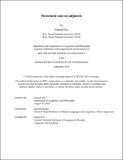| dc.description.abstract | This dissertation investigates how case is assigned to nominal adverbials dubbed durative and multiplicative in Korean. These adverbials express the duration of an event, or the number of times an event is repeated. In transitive, unergative, and unaccusative constructions, the adverbial is marked with accusative case. In psychological predicate constructions, the adverbial is marked with nominative case. Interestingly, in passive and inchoative constructions (grouped together under the term nonactive), the adverbial allows both nominative and accusative case.
I derive these patterns from a specific model of Voice, and a model of successive-cyclic Dependent Case. I first argue in favor of a Voice system that treats passive and inchoative constructions as syntactically equivalent: whether a nonactive construction is passive or inchoative is determined by the feature specification on Voice (Kallulli 2007). Furthermore, this nonactive Voice head introduces an implicit agent (for passives) or causer (for inchoatives), which can be optionally realized as a PP. This agent/causer at Spec, VoiceP competes with the theme argument to move to Spec, TP. Hence, there are two different structures that can arise in nonactive constructions. The other constructions that do not show case optionality lack this competition. In transitive, unergative, and unaccusative constructions, there is no implicit agent/causer at Spec, TP to compete with the theme argument. In psychological predicate constructions, the experiencer argument introduced at Spec, ApplP acts as an intervener and blocks the theme argument from competing with the implicit agent/causer.
My model of successive-cyclic Dependent Case explains how the different structures result in different case patterns. It is a revised version of Levin’s (2017) original model, whereby case evaluation occurs not only at the end of the syntactic derivation but at the Spell-out of each phase. However, my version of the model involves a more relaxed locality constraint for dependent case assignment. I demonstrate how my model can not only derive the case marking patterns of durative and multiplicative adverbials, but can also account for other case phenomena in Korean such as case stacking and multiple nominative constructions. | |
